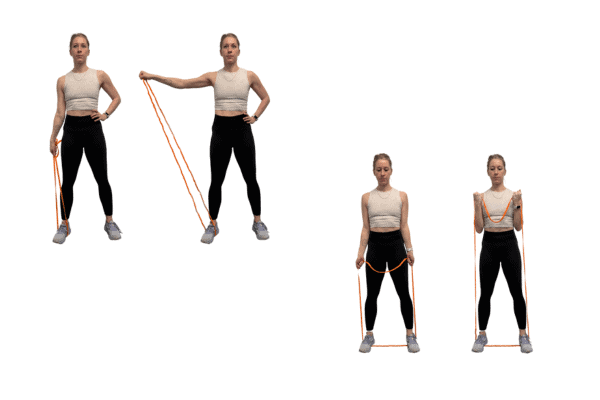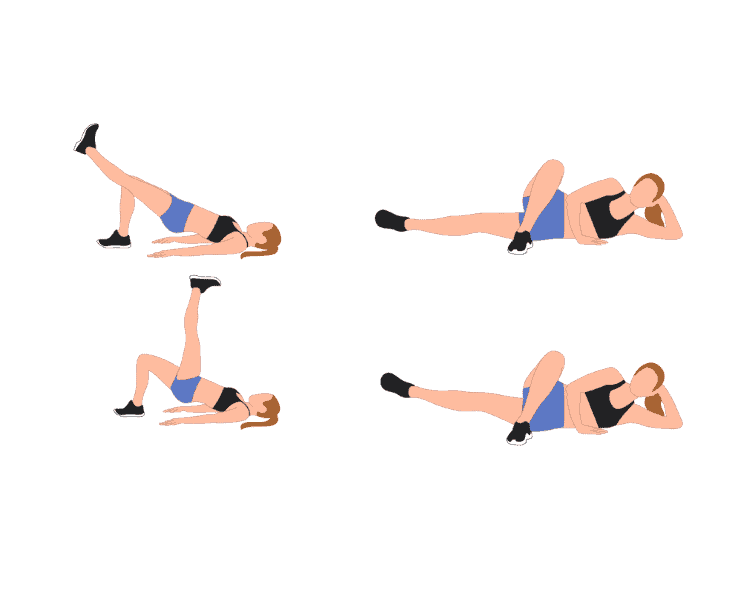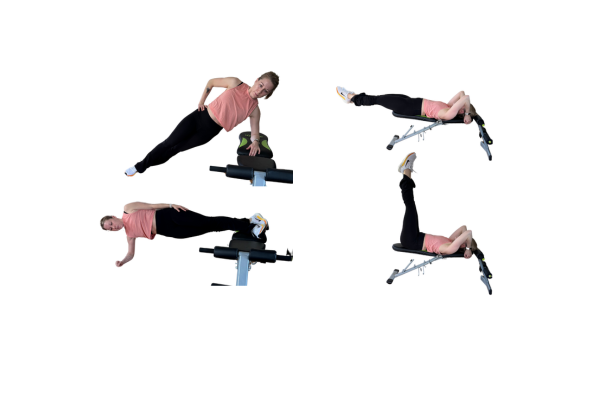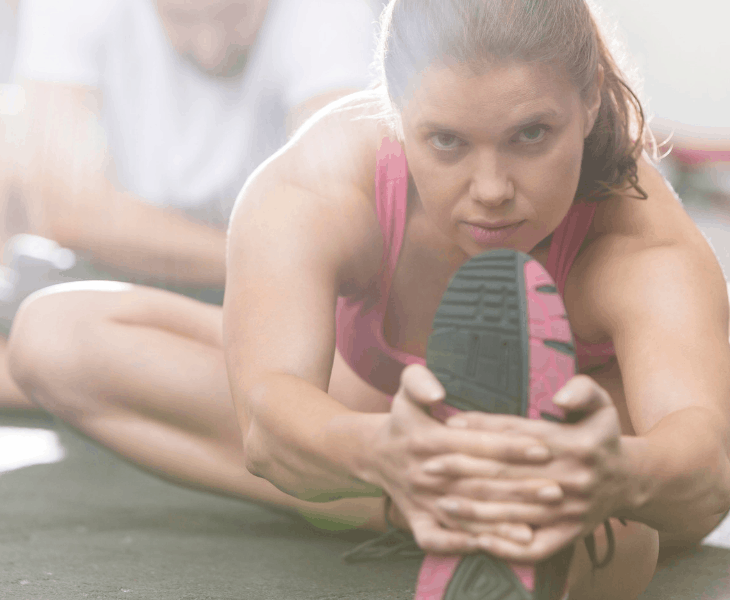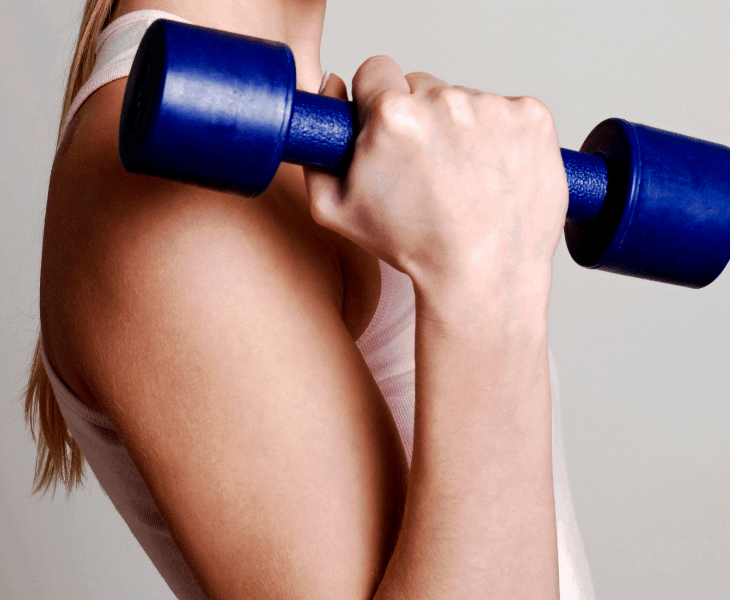Dumbbell Squat – Everything you need to know
This dumbbell squat guide will explain five dumbbell squat variations and teach you how to plan your squatting workout to fit your fitness goals.
You can use the dumbbell squat to build mobility, balance, strength, as well as build muscle or lose weight. Make sure to read about the dumbbell progression to prevent injury and learn about the proper posture before you get started.
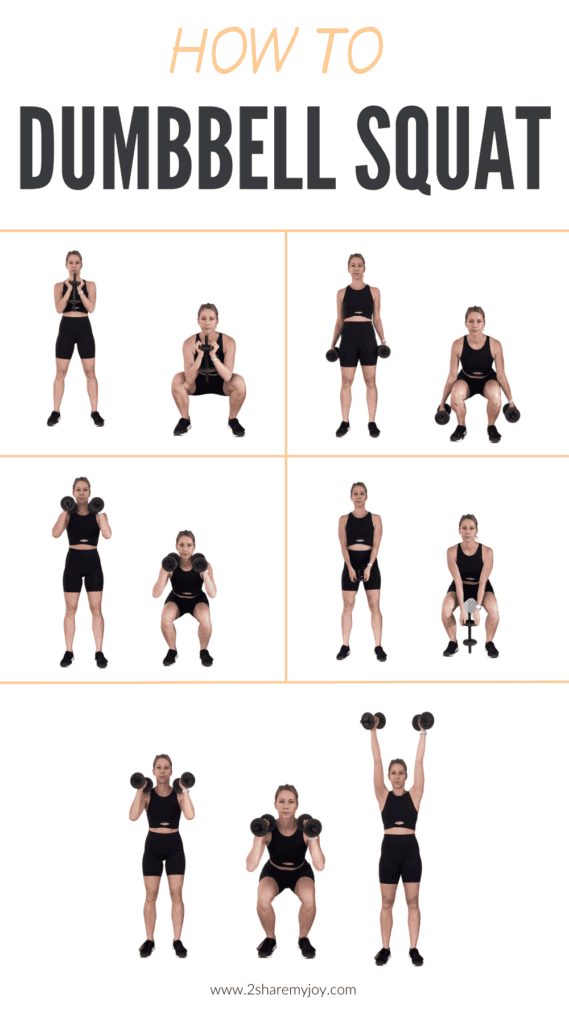
What is a Dumbbell Squat?
A dumbbell squat is simply a squat with added dumbbells. The added load can help achieve a variety of fitness goals. Just like the bodyweight squat, there are several variations of a dumbbell squat to target different muscles and fitness goals.
While squatting, you can hold your dumbbells in these positions:
- Dumbbell Squat – Arms hang to the sides
- Goblet Squat
- Front Dumbbell Squats
- Front Low Dumbbell Squat
- Dumbbell Squat to Overhead Press
There are many reasons to add weights to your squats. If you are able to do 20 bodyweight squats without getting sore, consider adding weights like dumbbells to your squat routine.
In order to reap the benefits of a squat, it is important to push your limits. Increasing the load will just do that. For optimal fitness improvement, increase your load or your repetitions by 10% each week.
Before you get started with dumbbell squats, read below to learn about the proper progression of the squat to prevent injury and overtraining.
What muscles is the dumbbell squat good for?
During the squat, the quadriceps and the gluteus maximus (large butt muscle) are mostly carrying the weight (Agonists).
However, you will also strengthen the stabilizing muscles, the muscles stabilizing your joints during the squat, which are your abdominals and external obliques (love handle muscles).
Furthermore, you’ll strengthen the stabilizing muscles (the muscles helping the agonist), which are the hamstrings and the back (erector spinae).
Dumbbell Squat Benefits
Squatting is a movement that is used in daily life. Picking up groceries or a child, lifting objects, and even sitting down or getting up.
Adding squats to your exercise routine will make many moves in your life easier and decrease the risk of injury during these daily activities.
Loaded squats (meaning squatting with a weight), has been shown to increase activation of the prime mover muscles, improving lower body muscular endurance, strength, power (source), and balance.
More benefits of loaded squats might be increased weight loss, speed, muscle growth, endurance, mobility, and posture.
Depending on what you want to accomplish, you need to adjust the weight, squat variation, tempo, repetition, sets, and rest period. More on that in the article below.
Squat Progression – What to do before you add dumbbells
If you are an exercise beginner, you might not be ready to add dumbbells yet. Some conditions might not allow for loaded exercise. Consult with your healthcare provider if this is right for you.
Before adding weights to your squat, it is important to build stability and strength first, as well as performing the squat in the right posture. If you compromise your posture or stability, do not add weights. This will lead to injury.
Perform a squat without weights first. If you get out of balance or you can’t perform the squat, practice an assisted bodyweight squat. To do so, squat into a seating position on a low bench or chair and back up.
Practice this until you can perform a squat without assistance. If this exercise is also too hard, practice a stability ball wall squat. And then work your way to a squat. Check out these squat alternatives for more ideas.
Once your posture and stability are optimal during the squat, you are ready to add weights.
If you master the dumbbell squat and want to challenge yourself, the next progressions are the barbell back squat, single-leg squat, and finally the squat jump.
5 Dumbbell Squat Variations and How-To
All squat variations below are excellent additions to your workout routine. Choose the one where you can maintain optimal posture.
Start with low weights and 12-20 repetitions with a set of 3. This will increase mobility and strength. Then you can transition into hypertrophy training and increase weights. For this type of training, do 8-12 reps.
For an optimal progression, aim to increase either the weight or the reps by 10% each week.
Postural Checkpoints for all dumbbell variations
For any of the mentioned dumbbell squat variations below, these checkpoints remain the same. Make sure to check yourself for optimal squatting posture to prevent injury and ensure the best performance.
- Feet: Feet are placed shoulder-width apart, pointing forward.
- Knees: Aligned over the second and third toe. Make sure they don’t cave inward.
- Hips: Your pelvis should not tilt forward or backward, and keep the spine straight. Make sure the hips are even and not tilting on one side.
- Shoulders: Don’t round your shoulders or pull them up towards your ears. Make sure they are pulled down and slightly back.
- Head: Keep your neck aligned with your spine in a neutral position.
Note: In some squat variations, like the sumo squat or barbell squat, you might turn your feet slightly outward to prevent your knees from collapsing inward.
1) Dumbbell Squat – Arms hang to the sides
With this squat variation, your arms hang to the side. This is an easy variation and great for beginners.
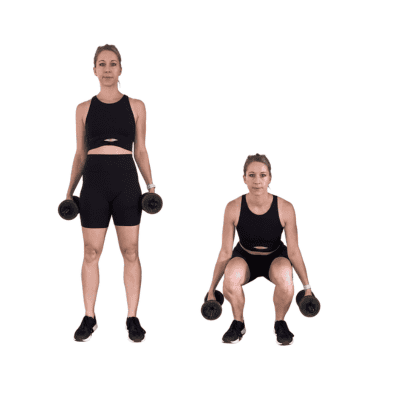
Grab one dumbbell in each hand and stand straight with your feet placed shoulder-width apart. Keep your shoulders down and slightly back and look straight forward.
Start to lower your body by bending ankles, knees, and hips. Your weight should shift slightly to the back of your foot.
Lower your body until your thigh bones are parallel to the ground or a bit lower. You can pause at the bottom, depending on your fitness goals.
Keep your arms hanging on the side.
To push back up, press your feet into the floor and squeeze your glutes. Go back into the standing position and start over.
2) Goblet Squat
With the goblet squat, you are using one dumbbell in front of your chest and your elbows will move between your knees. This is still a great variation for beginners. You can also do this with a kettlebell.
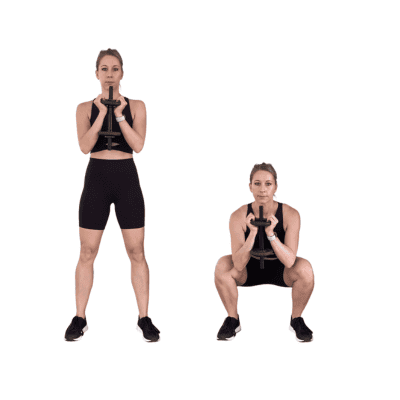
Stand with your feet shoulder-width apart and toes pointing straight forward. Grab the dumbbell with both hands around one side and keep it in front of your chest, or you can rest it lightly on your chest.
Squeeze your shoulder blades together and tighten your abs. Then start squatting.
Lower your body until your thigh bones are parallel to the ground or a bit lower. You can pause at the bottom, depending on your fitness goals.
Keep your chest up and your spine straight.
To push back up, press your feet into the floor and squeeze your glutes. Go back into the standing position and start over.
3) Front Dumbbell Squat
With the front dumbbell squat, you rest the dumbbells lightly on your shoulders. This variation lets you squat deeper, giving you a wider range of motion. You also have the benefits of adding more weight to your squat since you are holding two dumbbells.
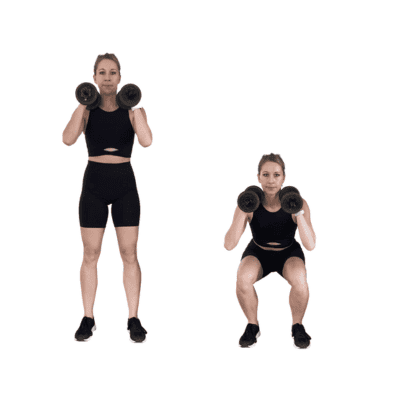
Place your feet shoulder-width apart and hold your dumbbells over your shoulders.
One end is pointing forward, the other end is resting lightly on your shoulder.
Don’t raise your shoulders to lift the weight and maintain optimal posture like explained above.
Lower your body until your thigh bones are parallel to the ground or a bit lower. You can pause at the bottom, depending on your fitness goals.
Keep your chest up and your spine straight.
To push back up, press your feet into the floor and squeeze your glutes. Go back into the standing position and start over.
4) Front Low Dumbbell Squat
For this dumbbell squat, you will hold one or two dumbbells in front of your body but let them hang low. This variation changes the movement slightly, making it similar to a front row.
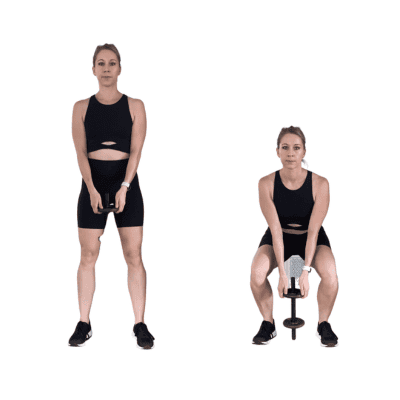
The squat will also strengthen your back a bit more, but the range of motion is reduced due to the dumbbells being closer to the floor.
Grab one or two dumbbells and stand straight with your feet placed a little more than shoulder-width apart. Keep your arms hanging straight in front of you.
Start to lower your body by bending ankles, knees, and hips. Your weight should shift slightly to the back of your foot.
Lower your body until your thigh bones are parallel to the floor. You can pause at the bottom, depending on your fitness goals.
To push back up, press your feet into the floor and squeeze your glutes. Go back into the standing position and start over.
5) Dumbbell Squat to Overhead Press
This squat variation is similar to the front dumbbell squat, but you are pressing the dumbbells up in the standing position. This makes it a full-body exercise and targets more muscle groups. It is a great choice if you need to burn more calories or want a quicker workout.
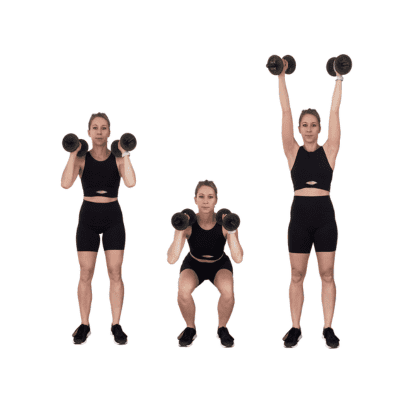
Place your feet shoulder-width apart and hold your dumbbells over your shoulders.
Lower your body until your thigh bones are parallel to the ground or a bit lower. You can pause at the bottom, depending on your fitness goals.
Keep your chest up and your spine straight.
To push back up, press your feet into the floor and squeeze your glutes. Go back into the standing position and start over.
While standing, press the dumbbells up and back down. Don’t raise your shoulders to lift the weight, and maintain optimal posture as explained above.
Start from the beginning.
Dumbbell Squat For Different Fitness Goals
Varied squat tempos, loads, repetitions, and sets can yield different fitness outcomes. Read more to discover the best dumbbell squat exercise routine for your objectives and lifestyle.
Mobility/Stabilization/Beginner
If you are a dumbbell beginner, start by practicing squats without weights. Ensure you execute the motion with proper posture and balance. Once you can perform 12-20 squats with optimal form, you can introduce light dumbbells.
As an exercise novice, your initial goals should focus on balance, muscle strength, and flexibility to ensure optimal range of motion and mobility. Employ light weights (2-5 lbs), do 12-20 repetitions of the squat, and aim for 1-3 sets. Keep rest intervals no longer than 90 seconds between sets.
During this phase, descend into the squat over 4 counts, pause and hold for 2 counts, and rise in 1 count.
For the subsequent week, consider either increasing weight or repetitions by 10% for optimal progress.
Strength Endurance
To progress into strength building, integrate 2-4 sets of squats with heavier weights. Choose dumbbells ranging from 5-15 pounds. Gauge the number of squats you can complete until exhaustion.
During these squats, lower over 2 counts, without pausing, and rise over 2 counts.
Subsequently, calculate 70-80% of your maximum dumbbell squat count. This becomes your starting repetition count, ideally falling within the range of 8-12. Adjust as needed.
Hypertrophy
For muscle building via dumbbell squats, reduce repetitions to 6-12, target 3-5 sets, and utilize 75-85% of your maximal dumbbell squat count. Increase the weight from the strength endurance phase.
Retain the 2-count descent and ascent without pause at the bottom. Limit pauses between sets to no more than 60 seconds. Elevate load (weight) or repetitions by 10% weekly.
Weight Loss
Muscle gain aids weight loss, yet optimizing workouts for weight loss entails eliminating pauses between sets and targeting additional muscles through dumbbell squat to overhead presses. This dynamic variation burns more calories and streamlines workouts.
Remember that tailored variations in squat tempo, load, repetition, and sets can effectively tailor your dumbbell squat routine to your specific fitness objectives.
Now, it’s your turn to dive into the article and enjoy the multitude of benefits that dumbbell squats bring to your fitness journey.
This dumbbell squat guide will explain five dumbbell squat variations and teach you how to plan your squatting workout to fit your fitness goals.
You can use the dumbbell squat to build mobility, balance, strength, as well as build muscle or lose weight. Make sure to read about the dumbbell progression to prevent injury and learn about the proper posture before you get started.

